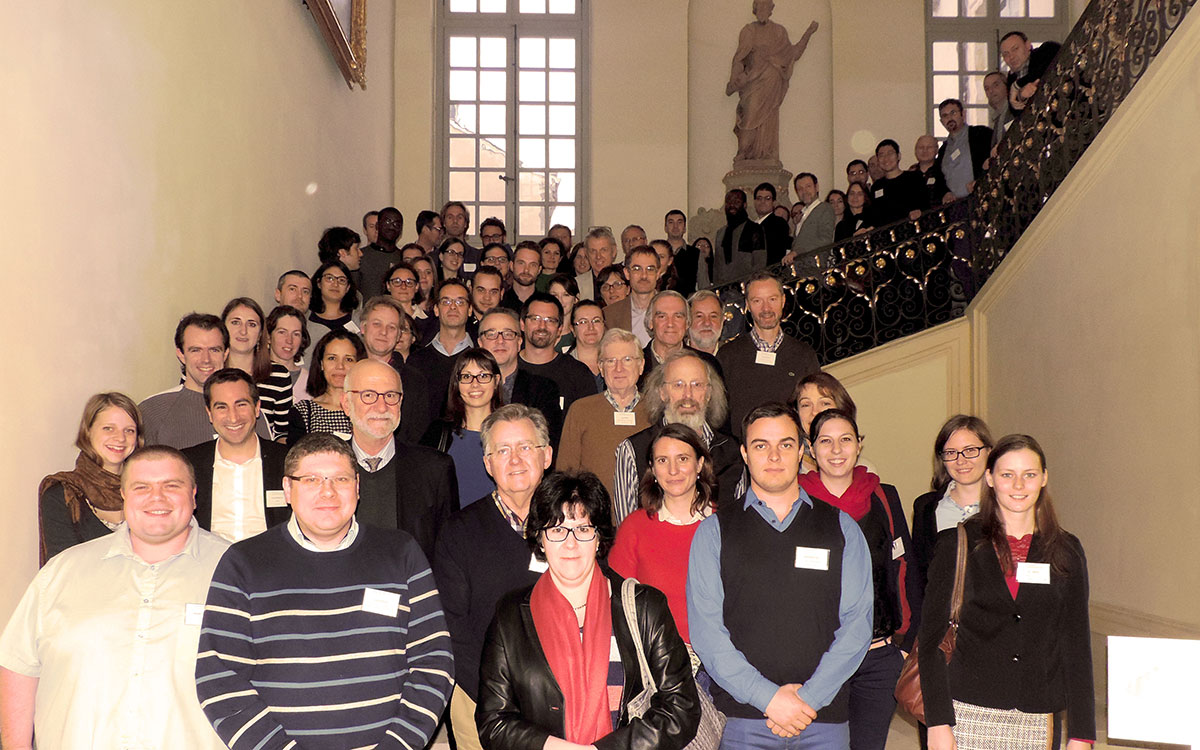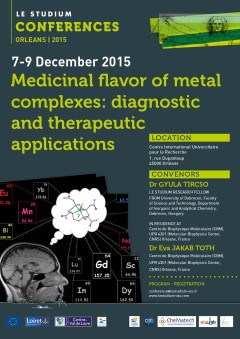Medicinal flavor of metal complexes: diagnostic and therapeutic applications
Hôtel Dupanloup
1, rue Dupanloup
45000 Orléans
France
Presentation
CONVENORS
- Dr GYULA TIRCSO , LE STUDIUM RESEARCH FELLOW
FROM University of Debrecen, Faculty of Science and Technology, Department of Inorganic and Analytical Chemistry, Debrecen, Hungary
IN RESIDENCE AT Centre de Biophysique Moléculaire (CBM), UPR 4301 (Molecular Biophysics Center, CNRS) Orleans, France
- Dr Eva JAKAB TOTH
Centre de Biophysique Moléculaire (CBM), UPR 4301 (Molecular Biophysics Center, CNRS) Orleans, France
Introduction
Metal ions play essential roles in biochemical processes, but they are also very important in diagnostic and therapeutic medicine. Because of toxicity (of metal-based diagnostic agents) or delivery issues (therapeutic agents based on bifunctional ligands) require specific ligands, which can encapsulate metal ions by forming stable and inert complexes. Diagnostic applications like MRI rely on the use of compounds containing paramagnetic ions (e.g., GdIII, MnII, FeII) while complexes with radionuclides emitting positrons (e.g., 44Sc, 64Cu, 68Ga, 86Y) or gamma photons (e.g., 99mTc, 111In) are employed in PET or SPECT, respectively. Luminescent lanthanide complexes emitting visible (EuIII and TbIII) or near-infrared light (e.g. NdIII, PrIII, ErIII and YbIII) have found utilization in various fields of optical imaging. Among the therapeutic applications the targeted radioimmunotherapy is being now more and more favored over the chemotherapy which rely on radionuclides that generate alpha (e.g. 212Pb, 212Bi) or beta (e.g. 90Y, 177Lu) particles but still require chelating ligands for delivery. The “LE STUDIUM® CONFERENCE” entitled “Medicinal flavor of metal complexes: diagnostic and therapeutic applications” intends to bring together leading scientists, from around the world, working on metal complexes with an aim to see and discuss how the achievements in one field can aid the research and development in the other filed.

Group picture
INVITED SPEAKERS
- Prof. Dr. A. Dean Sherry
University of Texas at Dallas and University of Texas Southwestern Medical Center, Richardson and Dallas, TX, USA - Prof. Dr. Peter Caravan
Harvard Medical School and Massachusetts General Hospital, Charlestown, MO, USA - Prof. Dr. Carlos Platas-Iglesias
University of A Coruña, A Coruña, Spain - Prof. Dr. Imre Tóth
University of Debrecen, Debrecen, Hungary - Dr. Róbert Pál
Department of Chemistry, Durham University, Durham, United Kingdom - Prof. Dr. Clotilde Policar
Ecole Normale Supérieure (ENS), Laboratoire des BioMolécules, Paris, France - Dr. Célia S. Bonnet
Centre de Biophysique Moléculaire, CNRS, Orléans, France - Prof. Dr. Raphael Tripier
Université de Bretagne Occidentale, Brest, France - Prof. Dr. Sandrine (Markai) Huclier
University of Nantes, Nantes, France - Prof. Dr. Loïc Charbonniere
CNRS Strasbourg, Strasbourg, France - Prof. Dr. Steven J. Archibald
Positron Emission Tomography Research Centre and Department of Chemistry, University of Hull, Hull, United Kingdom - Prof. Dr. Carlos Frederico de Gusmão Campos Geraldes
University of Coimbra, Coimbra, Portugal - Prof. Dr. Philip Blower
Department of Imaging Chemistry and Biology, King's College London, London, United Kingdom - Dr. Svetlana V. Eliseeva
Centre de Biophysique Moléculaire, CNRS, Orléans, France - Dr. Goran Angelovski
Max Plank Institute for Biological Cybernetics, Tübingen, Germany
Programme
1st Day - 07/12/15
12:00 Registration/Welcome Lunch
13:30 Official opening
- President of LE STUDIUM Ary Bruand;
- Scientific director of LE STUDIUM, Prof. Nicola Fazzalari
13:40 Sponsorship acknowledgement with a special thank to the University of Debrecen
LE STUDIUM fellow, Dr. Gyula Tircso
13:50 Scientific opening
CBM Director Dr. Eva Jakab Toth
First session Chairman: Dr. Éva Jakab Tóth
14:00 1st presentation
Functional imaging of Zn(II) relelase from secretory cells by MRI Prof. A. Dean Sherry
14:45 2nd presentation
Scandium : is it the new generation of fashion theranostic agent? Dr. Sandrine (Markai) Huclier
15:15 Oral communication 1
Translating the activity of an enzyme analyte into beating the chelate effect Prof. Jens Hasserodt
15:35 Coffee break and Poster Section
Second session Chairman: Prof. Stéphane Petoud
16:35 3rd presentation
Designing and studying efficient azamacrocyclic chelators for nuclear medicine applications Prof. Raphael Tripier
17:05 4th presentation
Luminescent Lanthanide(III)-based Metallacrowns as Promising Agents for Optical Imaging Applications Dr. Svetlana Eliseeva
17:35 Oral communication 2
Near-Infrared Imaging of Necrotic Cells Using LnZn16 Metallacrowns Ivana Martinic
18:30 LE STUDIUM LECTURE
Les métaux et la vie Prof. Clotilde Policar
2nd Day - 08/12/15
08:45 Registration/Welcome Coffee
Third session Chairman: Prof. A. Dean Sherry
09:00 5th presentation
Molecular MR Imaging Prof. Peter Caravan
09:45 Oral communication 3
Stability of Cu(II) Chelates based on thiazolyle-cyclam derivatives for PET Imaging Dr. Véronique Patinec
10:05 6th presentation
In the Pursuit of Higher Resolution in Optical Microscopy: From Lanthanides to Super-Resolution Dr. Róbert Pál
10:35 Coffee break
Fourth session Chairman: Prof. Lothar Helm
11:05 7th presentation
Responsive MRI contrast agents Dr. Célia S. Bonnet
11.35 Oral communication 4
A nanogel approach to tune conventional MRI Contrast Agents into hypersensitive MRI probes: application to Lymph Node Molecular Imaging (LNMRI) Dr. Cyril Cadiou
11:55 Oral communication 5
"Exploring the potentialities of two-photon lanthanide luminescent bioprobes" Anh Thy Bui
12:15 Lunch
Fifth session Chairman: Prof. Peter Caravan
14:00 8th presentation
Nuclear Chocolate Box – the Periodic Table of Nuclear Medicine Prof. Philip Blower
14:45 9th presentation
Chemokine receptor targeted radiopharmaceuticals and radiolabelled nanoparticles for positron emission tomography imaging Prof. Steven J. Archibald
15:15 10th presentation
Bioresponsive Nano-sized Contrast Agents for Functional MRI Dr. Goran Angelovski
15:45 Coffee break and Poster session
Sixth session Chairman: Prof. Kristina Djanasvili
16:45 11th presentation
Inorganic Cellular Chemistry: Anti-Superoxide Complexes Evaluated in Cells and Metal-Carbonyl Derivatives for IR-imaging Prof. Clotilde Policar
17:15 Oral communication 6
Synthesis and preclinical evaluation of a 64Cu-labeled ligand of the prostate specific membrane antigen (PSMA): A promising radiopharmaceutical for prostate cancer imaging. Dr. Victor Goncalves
17:35 Oral communication 7
A premier on structural tricks applied to accelerate formation kinetics of radiometal - macrocyclic ligand complexes Dr. Gyula Tircsó
17:55 Oral communication 8
Solution coordination chemistry as a first step in qualifying new chelators designed for nuclear medical applications Dr. Michel Meyer
20:00 Conference gala dinner
3rd Day - 09/12/15
08:45 Morning coffee
Seventh session Chairman: Prof. Petr Hermann
09:00 12th presentation
Formation kinetics of M(III)DOTA complexes: similarities and differences in aqueous solutions and water –ethanol mixtures Prof. Imre Tóth
09:30 13th presentation
Some Mn(II)/Mn(III) complexes as alternative potential MRI contrast agents Prof. Carlos F.G.C. Geraldes
10:00 Oral communication 9
"Gd(III) complexes appended to porphyrin sensitizers: water-soluble theranostic agents for MRI and one/two-photon PDT" Dr. Angélique Sour
10:20 Coffee break
Eigths session Chairman: Prof. Imre Tóth
10:50 14th presentation
From molecules to nanoparticles: exchanging rules in lanthanide based luminescent compounds Dr. Loïc Charbonniere
11:20 15th presentation
Exceptionally inert lanthanide(III) PARACEST MRI contrast agents based on 18-membered macrocyclic platforms Prof. Carlos Platas-Iglesisas
11:50 Oral communication 10
Smart theranostics: a useful tool for tracking metal-based complexes Dr. Ewen Bodio
12:10 Oral communication 11
Lanthanide Containing Liponanoparticles in Theranostic Approaches Dr. Éva Jakab Tóth
12:30 Conclusions & closing ceremony
Scientific conclusions: Prof. Nicola Fazzalari and Dr. Éva Jakab Tóth
Closing speech: Dr. Éva Jakab Tóth and Dr. Gyula Tircsó
12:40 Lunch - sandwich bar & take away
TOPICS:
- Chemistry of Contrast Agents (CA’s) in Magnetic Resonance Imaging (MRI) and its implications to the ligand design in other fields: (state of the art, Gd3+ and non-Gd3+-based CA’s, smart imaging agents, imaging at molecular level, etc.).
- Trends in nuclear medicine (diagnostic and therapeutic isotopes and applications, ligands design, new radiolabeling strategies, etc.).
- Ln3+ complexes for diagnostic applications in optical imaging (luminescent Ln3+ complexes, lanthanide(III)-ion based biosensors, etc.).
PRACTICAL INFORMATIONS
- The conference is expected to start at 13h30 on Monday the 7th of December, 2015 and will be finished by the noon on the 9th of December, 2015
- Registration open till November 1st, 2015 - Please note number of seats for oral presentations are limited.
- List of hotels in the center of Orléans
- List of restaurants in the center of Orléans









